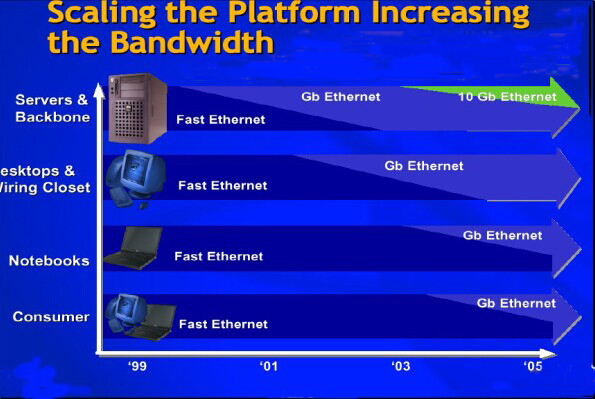Due to more and more internet users, the new applications become more various, such as Storage network, Internet data center, CAD/CAM, Multimedia and video order programs, Telemedicine, Distance learning course and other applications, all these applications need a lot of bandwidth. It is quite strict to the bandwidth of MAN and access network at the first kilometer. High speed data transmission means that the speed of a PC or server LAN ports needs to be improved to meet the new applications. At the same time, because of the rapid developments of semiconductor, 1000Base-T Gigabit Ethernet instantly become a boom.
Once we talk about 1000Base-T Gigabit Ethernet(also called IEEE 802.3ab), is a standard for Gigabit Ethernet over copper wiring. Each 1000BASE-T network segment can be a maximum length of 100 meters (330 feet) and must use category 5 cables or better (including Cat 5e and Cat 6). 10Base-T and 100Base-T are required to be mentioned, 100 Base-T, also Fast Ethernet, is simply 10Base-T running at 10 times the bit rate. Related product: 10/100/1000BASE-T Ethernet SFP. Since we know that 100Base-TX standards are compatible with 10Base-TX networks, the Fast Ethernet can make 10 Mbps and 100 Mbps bit rates on the line. Nodes with 100Mbps capabilities can communicate at 100 Mbps, and they also can communicate with slower nodes at 10 Mbps, so Fast Ethernet is the natural process of standard Ethernet, and then make the existing ethernet to be easily updated.
Fast Ethernet has been developed to 1000 Mbps (Gigabit Ethernet) on UTP cables. Gigabit Ethernet, specified as 1000Base-T, operates today over category 1 and category 5e cabling. When the ratification of 1000Base-T was done, migration of the installed base of category 5 to a higher speed Ethernet was the primary concern for network managers because they wanted to future proof their network infrastructures. While 1000Base-T Gigabit Ethernet was specified to run over category 6 cabling, most of the cabling installed that time was category 5. So the IEEE has to ensure the operation of 1000Base-T standard over the category 5 cabling systems installed according to the specifications of ANSI/TIA/EIA 568 A. The mainly goal of the IEEE 1000Base-T standard is to support the legacy category 5 cabling so that there should be no need to replace existing category 5 cabling to use 1000Base-T. According to the tack force, any link that is currently using 100Base-TX should easily support 1000Base-T. Related Product: 1000BASE-T SFP
How 1000BASE-T Gigabit Ethernet Works
As an extension of standard Ethernet technologies to gigabit-level network speeds, 1000BASE-T is normally implemented using the commonly installed category 5 cabling or enhanced category 5 cabling version of UTP cabling (for example, category 5e). Unlike using only two pairs of wires in 10BASE-T and 100BASE-T networks, 1000BASE-T uses all four cable pairs for simultaneous transmission in both directions through the use of adaptive equalization and a five-level pulse amplitude modulation (PAM-5) technique.
In the process of transmitting a 1000 Mb/s data stream over four pairs of Category 5 twisted pair cables, there are certain associated problems caused by factors as attenuation, crosstalk, and echoes arising from full-duplex transmission over single wires. To solve these problems, special filters, the PAM-5, forward error correction techniques and pulse shaping technologies are specified to make 1000BASE-T a functional and reliable networking technology. The special filters are for hybrid circuits used in full-duplex transmission over single wires. The PAM-5 provides better bandwidth utilization than binary signaling. Forward error correction techniques provide a second level of coding that helps to recover the transmitted symbols in the presence of high noise and crosstalk. Pulse shaping technologies match the spectral characteristics of the transmitted signals to those of the channel in order to maximize the signal-tonoise ratio.
Nowadays the 10 Gigabit Ethernet Alliance has been held in order to promote and accelerate the introduction of 10 Gigabit Ethernet into the fiber optic networking market. It was built by fiber optic networking industry leaders, such as 3COM, Cisco Systems, Extreme Network, Intel, Nortel Networks and other famous companies. Related product: Cisco GLC-T 1000BASE-T. Additionally, the alliance support the activities of IEEE 802.3 Ethernet committees, more force the development of the 802.3 ae (10 Gigabit Ethernet) standard, and promote interoperability among 10 Gigabit Ethernet products. The IEEE standards association unanimously approved the IEEE 802.3ae specification for 10 Gigabit Ethernet as an IEEE standard. I believe that in the near future, Ethernet will have a more comprehensive development as with continuous improvement of the system.
Related Article:
A Quick Overview of Cisco 1000BASE-T GLC-T SFP Copper Module

